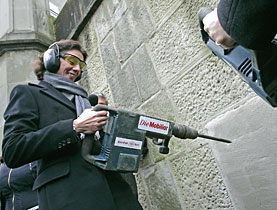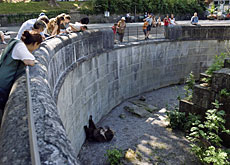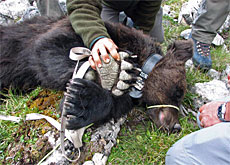Bear necessities enter 21st century

A 500-year-old tradition is getting a new lease of life: on Monday the first step was taken in the construction of a new bear park in the Swiss capital Bern.
A hole was ceremoniously drilled in the wall of the current bear pit, marking the entrance of a tunnel which will lead the bears into their own park with trees and bushes. From there they will be able to amble down to the River Aare to swim and catch fish.
The park will cover a total area of 6,500m² – ten times larger than the bear pits.
“They will be able to live like real bears – in the middle of the city,” said city councillor Barbara Hayoz, who has been nicknamed the “bear mother” as a result of her efforts in keeping the project alive.
When the park opens in 2009, visitors will be able to watch the animals from the existing terrace near the bear pit, and also from a path running along the riverbank.
Security plans
Safety will naturally be paramount. Everything has been considered, even drastic contingency plans for major flooding, such as occurred in 2006.
“We should be able to entice them back into the pit with food,” zoo director Bernd Schildger told swissinfo.
“If for some reason that fails, a vet will tranquillise them and we’ll bring them back in a van. If the vet is sick, and if there are no other vets for 100km, then, and only then, we’ll shoot them.”
Fortunately, it’s a big “if”.
In the past there have been more than a dozen bears in the pit at the same time; currently there are only two: brother and sister Pedro and Tana, both born in 1981. It is hoped they will be the first in the new park; it is certain they will be the last in the pit.
A female successor is already living in Bern zoo, in much more animal-friendly conditions. Helsinki zoo has a male ready to be sent.
Long time coming
The park project has been in the air for a number of years, but at SFr16 million ($14.5 million) the original idea was too expensive, and the plan seemed doomed.
Hayoz breathed new life into the project in 2005 when she took over the city department for safety, environment and energy. She managed to get the plans redesigned to bring the cost under SFr10 million and she persuaded donors to open their purses.
Not only companies and organisations, but also private individuals, rich and poor, have been generous in providing funds. Last year a sponsored run through the Old City raised SFr236,000.
The townspeople have shown their support not only in giving money, but also in voting the project through. All such major construction work has to be put to a popular vote; in June 88 per cent of voters approved the bear park.
Popular tradition
The Bernese are very fond of their bears. Visiting them and throwing them food has been a popular pastime for generations; every Easter cubs born during the winter used to be presented to the public in a special ceremony.
For centuries bears featured in processions and today the Bernese carnival begins with the “freeing of the bear” in which a lifelike bear figure is released from one of the old city gates.
But over the years locals and visitors have grown more and more uneasy about the conditions in which the bears are kept. The current pit opened in 1857.
It was made more bear-friendly in the 1990s, with improvements to the pond and the addition of stone blocks for the bears to climb, but this was not felt to be enough. Almost before it re-opened, someone scrawled on it the slogan “Free the Bears!”
It was not a new call. More than 90 years ago it is said that Lenin – who lived in Switzerland before the 1917 Russian revolution – used to throw them carrots and shout: “The bears must be freed!”
Now they have only a year to wait. The “freeing of the bear” will finally be more than a mere carnival event.
swissinfo, Julia Slater
Bears have a long association with Bern. According to legend, the founder of Bern, Berchtold V von Zähringen, named his new city after the first animal he killed in a hunt near the site of the bear pit. It was a bear – or Bär in German. This is why the city’s coat of arms features a bear.
Bears have been kept in Bern for about 500 years. The current bear pit is the fourth.
There are a number of bear statues all over the city, including on several of the 16th-century fountains.
“Persons of all ages and of all ranks are never weary of gazing at the animals, and hang over the wall in fond delight; the opulent sometimes spend a halfpenny in pears or gingerbread to throw to the bears… If the bears catch a piece of gingerbread in their paws, the happiness of the spectator is complete. This is the only notion a Bernois can form of pleasure.”

In compliance with the JTI standards
More: SWI swissinfo.ch certified by the Journalism Trust Initiative


You can find an overview of ongoing debates with our journalists here. Please join us!
If you want to start a conversation about a topic raised in this article or want to report factual errors, email us at english@swissinfo.ch.